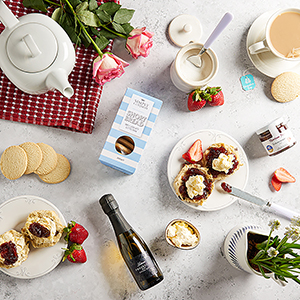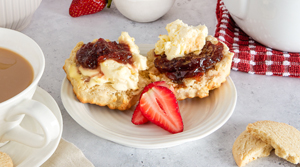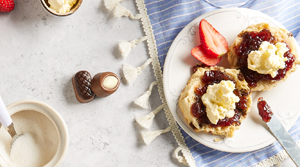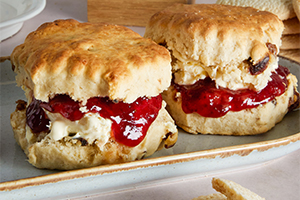
Which way will you have your cream tea?
When it comes to scones, cream and jam (or should it be – jam and cream – eek!), at hampers.com, we have found ourselves in the middle of a massive debate.
It started off so simply…
”Let’s develop an extra tasty cream tea hamper”
”Let’s take some nice photographs to show off the products”
”In the photograph, let’s have the delicious scones all prepared with jam and cream”
Easy, right? …Wrong!
Should the scone have cream on top of the jam? Or should the cream go first and then the jam on top?
We decided to investigate and unearthed a war of opinions, fought valiantly by many from Devon, Cornwall and beyond.
Want to find out more? Then, read on.
No time for debate? A staunch believer in one way or another? Is it #JamFirst or #CreamFirst?! Let us know.

Cornish cream teas vs Devonshire cream teas
To make it super clear, the difference between a Cornish and Devonshire Cream Tea is the order of the clotted cream (a non-negotiable inclusion, never to be substituted with any form of whipped cream) and jam (usually, but not exclusively, strawberry).
Cream first? Or jam first?
The Devon way is cream first, then jam.
The Cornwall way is jam first, then cream.
Those from Devon argue it is traditional to treat the thick clotted cream similar to butter. However, those from Cornwall argue that clotted cream goes on top, just like any other cream on top of a dessert. The Cornish even have a saying: “Don’t treat your clotted cream like butter, and your scone will be all the better”. …not sure if it is meant to rhyme!
Feelings about which is the ‘correct’ order have run high and felt strongly for many years.
History of the cream tea
The great cream and jam order debate
According to devonheaven.com, a cream tea originates from “…Tavistock Abbey in Devon, where the tradition of eating bread with cream and jam began in the 11th century.”
In an article in The New York Times, discussing clotted cream, it states that Cornish Food historian, Alan Davidson, suggests the origins go even further back, with the famous ingredient clotted cream, originating over 2000 years ago, when the Phoenicians (from what is now Lebanon and Syria) arrived in Cornwall. They traded their traditional way of making cream, called ‘Kaymak’, for Cornish tin.
Despite this long history, The Cream Tea Society, purports, however, that the cream tea tradition didn’t flourish until the 1850s, when tourism boomed, in the West Country, thanks to the opening of the railway.
In fact, the actual term ‘cream tea’ is not evidenced as in common use until the 20th century, with its first record mentioned in the newspaper, ‘The Cornishman’, in September 1931.

The cream tea debate in the media
The cream tea debate has rolled on for many years and involved many people.
The Queen's cream tea preference
Even the late Queen got embroiled in a media frenzy regarding cream teas. Darren McGrady, Former Chef to The British Royal Family, tweeted in 2018 that she always had jam first with clotted cream on top of her scones at garden parties at Buckingham Palace and at Royal tea parties. It caused an absolute storm with the Queen seemingly siding with the Cornish tradition.
We wonder whether King Charles shares the same preference.
The National Trust gets it wrong
Cream teas even made the BBC news, when the National Trust, posted an advert for a Mother’s Day Cream Tea at Lanhydrock, in Bodmin, in Cornwall, which included an image of scones in the Devonshire tradition.
It sparked many angry, as well as comedic comments, causing a bit of a Twitter storm. The hashtags #JamFirst, as well as the counter #CreamFirstandProud, starting a trend.
It prompted the National Trust to issue an apology, where they admitted their "heinous mistake" and the staff member responsible was "reprimanded and marched back over the Tamar". They also shared photos of #JamFirst badges, for staff to wear, in recognition and support of the “proper cream tea".
Protected status for cream teas - but which way?
To really stir outrage, a farmer in Devon, even tried to petition the EU to give cream teas protected status for the term ‘Devon Cream Tea’, much to the annoyance of the Cornish, many of whom believe their county has the greater claim to being awarded such a status.
Protected designation of origin means only food or product from a certain place can use the name, such as Champagne or Stilton. If the farm had succeeded only teas produced, processed or prepared in Devon could be called a cream tea.
Thankfully, for cross-country relations, the petition was unsuccessful.
A scientific study
Finally, let’s bring some scientific ‘evidence’ to the debate!
In 2015, food scientist, Dr Stuart Farrimond, and baker, Mich Turner, carried out some research. They concluded that the ‘perfect’ cream tea consisted of a 4:3:3 ratio: 40g scone served, topped with 30g of cream and 30g of jam to achieve the ideal level of sweetness and height.
However, the all-important question remains: in which order?
Controversially, Dr Stuart concluded that in their experimentation it was more practical to apply the cream first – the Devonshire Cream Tea order.

How can we decide which cream tea tradition is best?
Reasons for each
After intensive research and lots of taste-testing (of course!), here are the top reasons for each of the traditional methods for you to compare:
For Cornish Cream Teas:
– The clotted cream is often more expensive so can be used sparingly on top
– The jam is easier to spread first
– It looks more aesthetically inviting
– Cream usually goes on top of desserts - you don't put cream under a pudding
– The jam can’t slide off as easily
For Devon Cream Teas:
– Jam used to be more expensive so it's a tradition that you would put less on top
– The thickness of the clotted cream is more like butter – and you don’t put jam then butter on your toast
– It’s easier to get more cream on the bottom, on top it topples over
– The jam can be spread flatter making it easier to eat
– You are less likely to get cream on your nose
Fancy a cream tea?
Whatever your preference – Devon or Cornish – check out our new Afternoon and Cream Tea hampers, with all of the ingredients to dress your scones, however, you prefer - the Devon or Cornwall way.
We also have a great selection of gifts for any occasion, including cream teas and much more. Explore our full range and be inspired.
What would make your recipient feel extra special this year?
Next….shall we argue about how to pronounce ‘scone’ ?!








